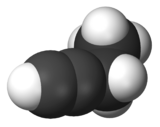1-Butyne

| |

| |
| Names | |
|---|---|
| Preferred IUPAC name
But-1-yne | |
| Other names
Ethylacetylene
Ethylethyne, UN 2452 | |
| Identifiers | |
3D model (
JSmol ) |
|
| ChEBI | |
| ChemSpider | |
ECHA InfoCard
|
100.003.139 |
| EC Number |
|
PubChem CID
|
|
| UNII | |
| UN number | 2452 |
CompTox Dashboard (EPA)
|
|
| |
| |
| Properties[1] | |
| C4H6 | |
| Molar mass | 54.091 g/mol |
| Density | 0.6783 g cm−3[1] |
| Melting point | −125.7 °C (−194.3 °F; 147.5 K)[1] |
| Boiling point | 8.08 °C (46.54 °F; 281.23 K)[1] |
| Hazards | |
| GHS labelling: | |
 
| |
| Danger | |
| H220, H280 | |
| P210, P377, P381, P403 | |
Except where otherwise noted, data are given for materials in their standard state (at 25 °C [77 °F], 100 kPa).
| |
1-Butyne is an organic compound with the formula CH3CH2C≡CH. It is a terminal alkyne. The compound is a common terminal alkyne substrate in diverse studies of catalysis. It is a colorless combustible gas.[1]
1-Butyne participates in reactions typical for terminal alkynes, such as alkyne metathesis,[2] hydrogenation, condensation with formaldehyde. Based on its heat of combustion, it is slightly more stable than its isomer 2-butyne.[3]
See also
References
- ^ ISBN 978-0-8493-0488-0.
- PMID 14709099.
- .

